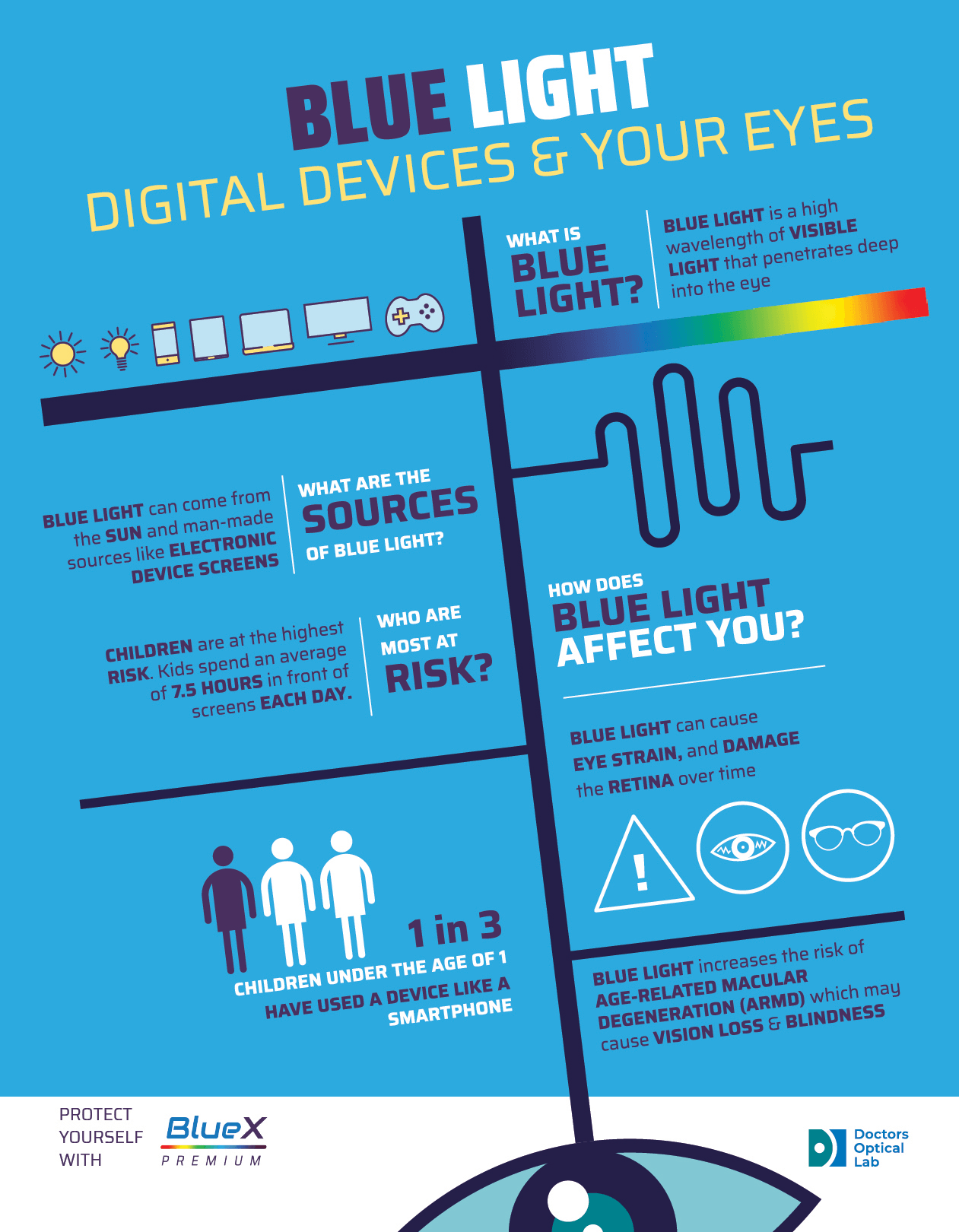$%blog.title%$
$%blog.excerpt%$
At Vue Optix, we believe in the importance of your right to privacy and personal data. We only collect personal information that you voluntarily provide to us when you create an account or place an order through our site. This information includes name, email, mailing address, phone number, payment or credit card information, and patient file such as your eyeglass prescription. We do not store any credit card information nor do we sell or lease your personal information. Please be aware that by using our site, you are consenting to receive notifications from us via email in regards to confirming an order, providing an invoice, and customer support.
Like most web servers, we use cookies to operate our site efficiently. We automatically collect information through the use of cookies which includes your IP address, the access date and time, the type of browser you used, the device you used, your login times, and purchasing behaviour. The data never contains your personal information such as your name, address, email, etc. You may disable cookies manually if you prefer, however, this may prevent you from accessing certain pages on our website.
Return Policy
We are confident that you’ll love our products from Vue Optix. But if you are not satisfied with your purchase for any reason, please contact us and we’ll arrange a one-time return or an exchange within 60-days of delivery.
Our 60-day Returns & Exchange Policy for contact lenses are as follows:
Customers are eligible to have a one-time exchange per item given that:
Customers are eligible to have a one-time return per item given that:
Please note:
Prior to the return/exchange is processed, the product must be inspected by our team members. All clearance items, sale items, contact lens solutions, eye drops, as well as custom-made contact lenses are final sale and they cannot be returned or exchanged. Each item may only be returned/exchanged once and Vue Optix reserves the right to limit the number of returns/exchanges at any given time. After the one-time exchange has been credited, the product becomes a final sale. Customers are responsible to pay the price difference of an item if the price of the originally purchased item is less than the price of the exchanged item. In contrast, if the originally purchased item price is greater than the price of the exchanged item, customers will receive a refund through the original payment method for the price difference. The shipping cost of your original purchase is non-refundable. If you have created an account with us, we will refund you with a credit on your account. If you have purchased an item as a guest, we will provide a voucher code via email for your refund. Store credit and vouchers will expire after 365 days.
Product Defect
If you notice any manufacturing defects, please contact us and we will replace your item within the warranty period of 365 days. Please do not attempt to repair the damage to the product. If any alterations are found, the return policy will not be applicable.
Damaged or Wrong Item
If you have received a wrong item or an item that has been damaged, we will provide a complimentary replacement of the product given that:
Please note:
Incorrect or damaged items will only be replaced with the same model, not refunded. The reported issue must be evaluated and confirmed by one of our team members prior to the replacement process. If the product damage was caused after the shipment arrival date, we will not be able to provide a replacement product. Please do not attempt to repair the damage to the product. If any alterations are found, the return policy will not be applicable. If an item that is wished to be exchanged is discontinued or out of stock, the customer may choose another item that is of equal to or lesser value.
Processing
Processing of an order can take up to 2 to 3 business days. You will be notified by email once the order has been processed.
Shipping Information
Standard shipping on orders can take up to 7-10 business days. The shipping rate is as follows:
|
Region |
Rate |
Estimated Delivery Time |
|
CANADA |
$15.95 CAD |
7-10 Business Days With Tracking Number With Designated Shipper (FedEx, ICScourier, Canada Post)* |
Subject to circumstances beyond our control such as shipping logistics and the ability to obtain products from our suppliers, we will do our best to ensure the overall production and shipping will not exceed 3 business days. *Custom-made products and special orders may take additional time for delivery.
Grace Period
Have a second thought after you submitted an order? No problem! Cancellation of an order can be made within 24 hours of an order confirmation for a full refund. If the cancellation is made after the 24-hour period, the order can no longer be cancelled. However, the item can be returned or exchanged given that the item meets the criteria mentioned under “Return Policy”.
Track Your Order
Once the order has been processed and verified, you will receive a tracking number in your email along with a tracking link. The link will transfer you to the designated shippers tracking page where you can input the tracking number which will allow you to check the status of your shipment. Our designated shippers include Canada Post, FedEx, and ICS.
Terms & Conditions for Vue Optix Contact Lenses
Valid Prescription Required
By placing an order for prescription eyewear and contact lenses with Vue Optix, you are certifying that the prescription you submit accurately matches the one that has been provided by your eye care professional. We only accept prescriptions that are valid, accurate, and in complete detail and we are not liable if the prescription that you have submitted is incorrect or false. In addition, you are further certifying that your prescription has been routinely renewed as per your eye care professional’s instruction, or when the prescription has expired. In order to mitigate errors from entering prescriptions manually on the site, we highly recommend uploading a copy of your original prescription by creating an account. Moreover, you warrant that you are not registered blind, or suffer from eye disease including, but not limited to, glaucoma, cataracts, and/or macular degeneration. Vue Optix reserves the right to contact your eye care professional to verify your prescription information if necessary.
Medical Advice Disclaimer
The contents of the site are used for general informational purposes only. As we are not medical professionals, we do not diagnose, provide advice or treat any medical conditions. Please visit a certified medical professional to seek help if you are experiencing any medical issues. For any medical emergencies, please call your doctor or dial 911 immediately. We disclaim all liability should you choose to rely on any health-related information provided by the site.
Colour and Product Accuracy
Though we strive to depict our products as accurately as possible on our site, we cannot guarantee the actual colour, texture or details of the product that appear on your monitor are accurate due to a wide variation in monitor screens. In addition, product information or pricing may contain typographical errors despite our best efforts to ensure integrity and accuracy on the site. Please be aware, that we do not warrant that the product images and item descriptions are current, reliable or free of errors. We are not liable should you choose to rely on the information provided by this site.
Payment
We accept most major credit cards and electronic payments including VISA, MasterCard and American Express.
Vue Optix reserves the right to reject the payment at any time if the payment appears to be fraudulent. In this circumstance, we will refund you through the original payment method and you may try to purchase with another payment form or cancel the order.
All prices are in Canadian Dollars (CAD) and they exclude taxes which are: Canadian Goods and Service Tax (GST), Harmonized Sales Tax (HST) and Provincial Sales Tax (PST). All prescription glasses and contact lenses are exempt from taxes as they are considered medical products. The tax rate will vary depending on the destination of the shipment address which will be reflected on the invoice.
Processing
Processing of an order can take up to 2 to 3 business days. You will be notified by email once the order has been processed.
Shipping Information
Standard shipping on orders can take up to 7-10 business days. The shipping rate is as follows:
|
Region |
Rate |
Estimated Delivery Time |
|
CANADA |
$15.95 CAD |
7-10 Business Days With Tracking Number With Designated Shipper (FedEx, ICScourier, Canada Post)* |
Subject to circumstances beyond our control such as shipping logistics and the ability to obtain products from our suppliers, we will do our best to ensure the overall production and shipping will not exceed 3 business days. *Custom-made products and special orders may take additional time for delivery.
Grace Period
Have a second thought after you submitted an order? No problem! Cancellation of an order can be made within 24 hours of an order confirmation for a full refund. If the cancellation is made after the 24-hour period, the order can no longer be cancelled. However, the item can be returned or exchanged given that the item meets the criteria mentioned under “Return Policy”.
Track Your Order
Once the order has been processed and verified, you will receive a tracking number in your email along with a tracking link. The link will transfer you to the designated shippers tracking page where you can input the tracking number which will allow you to check the status of your shipment. Our designated shippers include Canada Post, FedEx, and ICS.
Return Policy
We are confident that you’ll love our products from Vue Optix. But if you are not satisfied with your purchase for any reason, please contact us and we’ll arrange a one-time return or an exchange within 60-days of delivery.
Our 60-day Returns & Exchange Policy for contact lenses are as follows:
Customers are eligible to have a one-time exchange per item given that:
Customers are eligible to have a one-time return per item given that:
Please note:
Prior to the return/exchange is processed, the product must be inspected by our team members. All clearance items, sale items, contact lens solutions, eye drops, as well as custom-made contact lenses are final sale and they cannot be returned or exchanged. Each item may only be returned/exchanged once and Vue Optix reserves the right to limit the number of returns/exchanges at any given time. After the one-time exchange has been credited, the product becomes a final sale. Customers are responsible to pay the price difference of an item if the price of the originally purchased item is less than the price of the exchanged item. In contrast, if the originally purchased item price is greater than the price of the exchanged item, customers will receive a refund through the original payment method for the price difference. The shipping cost of your original purchase is non-refundable. If you have created an account with us, we will refund you with a credit on your account. If you have purchased an item as a guest, we will provide a voucher code via email for your refund. Store credit and vouchers will expire after 365 days.
Product Defect
If you notice any manufacturing defects, please contact us and we will replace your item within the warranty period of 365 days. Please do not attempt to repair the damage to the product. If any alterations are found, the return policy will not be applicable.
Damaged or Wrong Item
If you have received a wrong item or an item that has been damaged, we will provide a complimentary replacement of the product given that:
Please note:
Incorrect or damaged items will only be replaced with the same model, not refunded. The reported issue must be evaluated and confirmed by one of our team members prior to the replacement process. If the product damage was caused after the shipment arrival date, we will not be able to provide a replacement product. Please do not attempt to repair the damage to the product. If any alterations are found, the return policy will not be applicable. If an item that is wished to be exchanged is discontinued or out of stock, the customer may choose another item that is of equal to or lesser value.
COVID-19
Now more than ever, we believe the health and safety of our customers and staff to be the highest priority. We are following all the health guidelines and protocols by continuously disinfecting and sanitizing our facilities and our products to offer you a safer customer experience.
Please be advised, that though we endeavour to ship our products on a strict schedule, you may experience a slight delay in receiving your orders due to the current challenges of the COVID-19 pandemic. We truly appreciate your patience and apologize for any inconvenience this may have caused.
Frequently Asked Questions
Do you have any questions for us? Check out our FAQ below to get answers to all your questions regarding products, shipping, ordering process and more.
Prescription
Yes, you must visit an eye care professional to receive an eye exam in order to get a prescription. We offer eye exams with certified optometrists on-site. If you would like to book an appointment with us, please call (403) 764-6161 or click *here to book an appointment online.
Unfortunately no, we will not be able to take your eyeglass prescription for contact lenses. Contact lens prescription requires the base curve which determines the curvature of the lens as well as the diameter which determines the width of the lens to properly fit your eyes.
In most cases, prescriptions expire after a year or two. In order to get the most updated and accurate prescription, we recommend you visit an eye care professional to receive another eye exam.
Contact Lenses
Choosing the right type of contact lens depends on your lifestyle and your prescription. Your eye care professional will give you the best advice on which type of contact lenses that is most suitable for you.
Many teenagers or even pre-teens use contact lenses daily. However, we highly recommend consulting an eye care professional to see whether or not contact lenses are suitable for you or your child.
Yes, you can. We offer a wide variety of contact lenses specially made for astigmatism to fit your needs.
Since LASIK and other laser eye surgery work to reshape your eye, we recommend you to consult with an eye care professional to seek advice on whether or not contact lenses are suited for your needs.
That will depend on the type of contacts you choose and how frequently you decide to wear them. We offer a wide variety of affordable contact lenses so you can choose one that fits best with your budget and your needs.
Daily wear is meant to be disposed of after one-day single-use, while the planned replacement contact lenses are designed to be used over a specific time period advised by your eye care professional.
Your eye care professional will suggest the type of solution you will require based on your needs and lens type.
Some types of monthly contact lenses will allow you to wear them overnight. However, please be advised that prolonged use of contact lenses can lead to an increase in the risk of eye damage or complications. Therefore, we strongly advise you to consult with an eye care professional to seek all protocols and guidelines on whether or not you can wear your contacts overnight.
Absolutely. Unlike glasses, you do not have to be concerned about contact lenses falling or breaking while playing sports. Your eye care professional can help you determine the best suitable contacts for your particular sport or other activities.
Insurance/Payment Process
No, however, you will receive an invoice once the payment has been processed so you may request a reimbursement from your insurance provider. Please be advised that most insurance plans only cover prescription eyewear. Please contact your insurance provider ahead of time to see your full insurance coverage details.
We have sent a copy of your invoice through email. If you would like us to resend the invoice, please call us at (403) 764-6161 or email macleod@soloptixonline.com.
We accept most major credit cards and electronic payments including VISA, MasterCard and American Express.
All of our transactions are secured with Secure Socket Layer (SSL) technology which helps to encrypt sensitive information such as your credit card and other electronic payments. We do not store any credit card information once the transaction is completed.
Shipping
An estimated delivery time on orders is 7-14 business days. Special orders and custom-made products may take additional time.
Once your order has been processed, we will send a tracking number to your email. You can track your orders through the designated shipper's website using your tracking number.
Unfortunately no, we cannot send our shipments to P.O. box locations or hotels.
We ship our products with Canada Post.
Cancellation of an order can be made within 24 hours for a full refund. Please refer to the “Grace Period” page for more information.
Please call us at (403) 764-6161 or email info@vueoptix.com and we will check the shipment status on your order.
Return Policy
We offer a 60-day return and exchange policy for any unopened boxes of contact lenses.
Please call us at (403) 764-6161 or email info@vueoptix.com to initiate the return/exchange process.
If the product was incorrect, damaged, or contains a manufacturing defect, we will provide a free shipping label to ship the order back to us. However, if you would like to exchange or return an item for any other reason, you are responsible to pay for the shipping cost.
The refund process takes up to 7 days.

Filter by tags:
Search Blogs:
Sorry, no search results found.
$%blog.excerpt%$
If you've completed a comprehensive eye exam in the past, or have recently visited your optometrist, then they may have recommended taking retinal photos during your checkup.
Just like most people you may be wondering what retinal photos are and why you would opt-in for the added cost to your exam.
I mean, what's the point of paying more than you need to. Right?
Just because your vision is clear or your eyes 'feel' as though they're fine, it doesn't necessarily mean that your eyes are healthy.
The truth is, there are a number of ocular diseases and conditions that can creep up on you without any significant symptoms ever arising.
This puts you at risk of leaving underlying eye health issues unattended potentially causing greater harm to your eyes. Neglecting to address any issues with your eyes could limit your treatment options or decrease the likelihood of successful treatment.
So, what are retinal photos?
In short, retinal photos are high-quality images of the back of the eye that allows your optometrist or eye doctor to conduct a retinal exam and determine the health of your eyes in great detail.
To be fair, most eye exams will include some form of retinal examination.
However, what your doctor can see using traditional methods pale in comparison to the high-resolution images taken from the retinal photos.
If you're still unsure, that's OK.
This article will break down everything you need to know about retinal exams. Including digital retinal imaging, Optical Coherence Tomography (OCT) scans, what to expect in the exam, and why it's important to incorporate in your eye health routine.
Digital retinal imaging is the process of taking a digital, high-resolution image of your retina located in the back of your eye.
In the past, your optometrist or eye doctor would administer special eye drops to dilate your pupils. They would then look into your eye, specifically the retina, using instruments like a slit lamp with magnifying lenses or an ophthalmoscope.
Now, with digital retinal imaging, the latest technology gives your optometrist or eye doctor a high-quality, digital image of the inside of the eye and all of its internal structures.
This image is then used to study and track the overall health of the retina, the optic nerve, and other internal structures. They are then saved into your medical record to compare results from previous years.
An Optical Coherence Tomography (OCT) scan is another method of retinal imaging. The OCT scan is the latest advancement in non-invasive imaging technology.
The process is similar to an ultrasound but instead of using sound to create images, an OCT scan uses light waves to create a high-resolution image of the structural layers inside the eye.
The procedure involves using a low-powered laser, called a scanning laser, that scans the internal structures of the eye.
This technique of retinal imaging creates a three-dimensional scan of the retina at extremely high resolutions. The image captured displays a cross-section of the eye and is able to show each of the retina’s distinct layers.
The images are then analyzed by your optometrist or eye doctor for monitoring the overall health of the eye and to identify any abnormalities should they arise.
The assessment and the images are stored in your medical record to compare the condition of your retina year-over-year.

Apart from monitoring the overall health of your eyes, the optometrist or eye doctor can detect and manage a range of ocular conditions including:
This is usually signified by fluid leaking or bleeding at the back of the eye.
A dark spot at the back of the eye could be a sign of melanoma. Early detection allows for early treatment which may prevent or slow down serious damage and/or cancer spreading to the rest of your body.
Diabetes can cause changes in the blood vessels of the retina, such as swelling, leaking, or the creation of new blood vessels. Blindness is a major concern if left untreated
Unusual pressure against the optic nerve and the compression of blood vessels in the eye could be an early warning sign of glaucoma.
Signs of high blood pressure often first appear in the eye. Indicators could be narrowing of the blood vessels, spots on the retina, or bleeding at the back of the eye.
A retinal exam can spot early signs of the retina lifting or pull away from the wall of the eye before it causes significant damage to your eye health and vision.

Depending on the instruments available at your doctor's office, you may have your pupils dilated to begin the procedure. Other instruments do not require pupil dilation and this step may be skipped.
The dilation widens your pupils before the examination and typically takes about 20 minutes to take effect.
When your pupils have dilated enough for the OCT scan, you are sat down in front of the medical instrument and begin by resting your chin and forehead for the procedure.
You will be asked to stare straight ahead into the machine with your gaze fixed to an object while the scanning laser begins to scan your eye.
The image is then rendered and uploaded to the computer for the doctor to begin their analysis. The procedure is relatively quick and takes about five minutes after the dilation.
The procedure is quick and the results will be ready immediately after. The optometrist or eye doctor will report their assessment and let you know how your eyes have progressed since the previous exam.
Be mindful and plan ahead if you have to get your eyes dilated for the OCT scan. The effects of the dilation will remain for about 4 hours following your exam.
During this time your vision will be blurry and your eyes will be extremely sensitive to light as your pupils are wide open.
It's recommended to bring sunglasses for after your exam and to make sure you bring a friend or someone to drive you home afterwards.
Early detection can reduce the risk of serious damage or implications to the health of your eyes.
The first signs of ocular issues are seen in the retina. Retinal imaging allows your optometrist or eye doctor to detect any irregularities or deficiencies at the earliest stage
The data is easily stored in a database that can be recalled for future assessments. This gives your optometrist or eye doctor a year-over-year comparison of the health of your eyes.
Assessing the health of the retina not only promotes overall eye health but it can also identify other potential health concerns unrelated to ocular health.
Unusual or sudden changes to the retina are early warning signs to major health conditions such as cancer, diabetes, and high blood pressure.






A round face shape typically has rounded features with an equal length and width across the face. Round face shapes lack prominent cheekbones and have a rounded chin with very few angles.


Pick eyeglass frames that add more angles to the face like a square, rectangle or angular frames. Rectangle and square frame shapes offset the roundness and can make the face appear longer and thinner.
Oval face shapes are characterized by the overall balance in facial proportions. Typically, an oval face will have a small forehead, prominent cheekbones, and a thin jawline.


If you have an oval face shape you’re in luck. There are a variety of styles that would work well with an oval face and is considered the ideal face shape for glasses. The best rule of thumb for oval faces is finding eyeglass frames that are as wide (or a little wider) than the widest part of your face. Square and rectangular frames tend to add structure and contrast to the softer oval features of the face.
The square face shape is characterized by an angular jawline with equal proportions in the forehead and cheekbones.


Rounded shapes like round, oval, or browline frames complement the angular lines of square face shapes. It creates a pleasing balance between facial features and frame shape. Frame width is important to take into consideration for square face shapes. Find frames that sit wider on the sides to avoid glasses that look too small for your face.
The diamond face shape is one of the rarest of them all. A diamond face shape has prominent cheekbones accompanied by a narrow forehead and an angular jawline.


As a starting point, oval or round frames tend to complement a diamond face shape by softening the angular features of the face. Rimless and browline frames also help to balance and accentuate the best facial features for diamond-shaped faces. Cat-eye frames offer a bold and unique style for women.
A triangle face shape typically has a narrow forehead and is widest around the jaw. The face creates a triangular shape with the base down at the jawline.


Triangle face shapes do well with frames that mirror or add contrast to the shape of the face. Since the triangle face shape is widest at the jaw and narrows at the forehead, look to mirror the shape using frames with heavy accents at the top and lighter features at the bottom. This can be cat-eye or browline frames for women and rounded frames with top-heavy details like a wayfarer or browline frames for men.
A heart-shaped face has a broader width at the top portion of the face, typically from the cheekbones and forehead, then narrows down towards the chin.


Just like the triangle face shape, you can look to mirror the heart-shaped face by finding frames with heavier details on the bottom of the frame and lighter at the top. Look for eyeglasses with a geometric shape or an aviator-style frame. Round frames would also work well by softening the angular features of a heart-shaped face.
Artificial light is all around us - whether it’s a lamp in your room or overhead lights at work, they illuminate our environment so we are not living in darkness.
Not only that, but we are spending more time than ever before in front of screens like computers, mobile phones, and tablets.
These artificial light sources have been so engrained with our way of life that we tend to overlook the effects that these light sources have on our human biology.
Studies have found that exposure to light has a direct relationship with how our bodies regulate between the sleep-wake cycles - especially blue light.
Blue light can cause major implications to your sleeping pattern and maybe the reason why you’re having trouble falling asleep or staying asleep at night.
That doesn't mean that we should avoid artificial light sources because the benefits of artificial light are undeniable. There’s no way we would be able to function without it in the world we live in today.
However, it is important to understand that there are consequences from the constant bombardment of blue UV light emitted by these artificial light sources.
Let's get into it.
Light is comprised of a spectrum of light rays ranging from red, orange, yellow, green and blue. Light rays are not created equal and each has specific characteristics.
Light rays on the red side of the visible light spectrum have longer wavelengths and less energy, while light rays on the blue side have short wavelengths and more energy.

A 1981 study conducted by Dr. Charles Czeisler of Harvard Medical School found that daylight regulates your circadian rhythm with the environment around you.
Circadian Rhythm
A circadian rhythm is approximately a 24-hour cycle in the physiological processes of living beings, including plants, animals, fungi and cyanobacteria. It is often referred to as the “biological clock” and determines our sleeping and eating patterns.
Each individual’s circadian rhythm will vary - people that tend to stay up late (night owls) will have a slightly longer circadian rhythm and those who are prone to waking up early (early birds) will have a shorter circadian rhythm.
Effects of Blue Light
Blue light is not all bad. In fact, light and blue wavelengths are actually beneficial for you. Blue light elevates your mood, increases your reaction time, and makes you more attentive and alert.
Perfect for daytime tasks and activities.
The problems occur in the evening when we need to rest and sleep. The prevalence of artificial lighting and screens, especially after sundown, disrupts our ability to fall asleep.
Exposure to light has been known to suppress melatonin secretion. Melatonin is a hormone that greatly influences your circadian rhythm by regulating your sleep cycle.
Your body begins to produce melatonin in the evening, when it’s dark, signalling your body that its time for sleep. In the morning, daylight has the opposite effect and signals your body to produce less melatonin to prepare for your daily activities.
Daylight is not the only form of light that has an effect on your body’s ability to produce melatonin. In general, all light will suppress melatonin secretion.
However, blue light is the most powerful wavelength in the visible light spectrum and affects melatonin secretion at a much greater scale.
Our bodies have used light as a way to calibrate itself to the environment we live in. Unfortunately, our systems have been compromised with the rise of modern technology.
The advent of artificial lighting, screens from daily gadgets (TVs, computers, mobile phones etc.) and energy-efficient lighting create a conflict with how our bodies regulate our sleep-wake cycles.
LEDs or light-emitting diodes have become increasingly popular because they are far more energy-efficient than fluorescent bulbs.
They can be found in both lighting systems and screens for your devices. Although LEDs require less energy to produce light they are a culprit for producing more blue light.
Blue Light Case Study

A Harvard study was conducted outlining how different types of light affect melatonin secretion. In the experiment, researchers from Harvard exposed the subjects to blue and green light independently for 6.5 hours with equal brightness of each colour.
What did the researchers find?
They concluded that blue light suppressed melatonin secretion and shifted circadian rhythms by double the amount compared to exposure from green light (3 hours vs 1.5 hours).
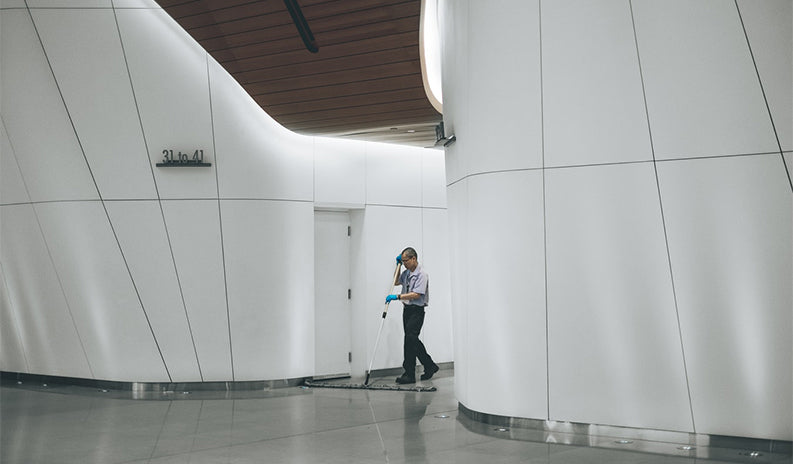
Another study was done by researchers at the University of Toronto looking into the effects of blue light on an individual’s melatonin levels.
In the study, the researchers from the University of Toronto analyzed the differences in melatonin levels for people that work in bright indoor lighting environments who wear ‘blue-light-blocking’ goggles and people that did not wear ‘blue-light-blocking’ goggles in dim light.
What were the results of the study?
The researchers at the University of Toronto found that the melatonin levels between the two groups studied were relatively similar to each other.
So, what does this mean?
The evidence points to a strong relationship between the suppression of melatonin secretion caused by blue light.
Exposure to light with high amounts of blue wavelengths are conducive to working under bright environments with indoor lighting.
The results found that wearing blue-light-blocking goggles reduces the adverse effects of blue light on melatonin secretion to similar levels as being in an environment with dim lighting.
This further supports the hypothesis that blue light has a direct influence on the production of melatonin.
This means that overexposure to blue light can disrupt your circadian rhythm which can result in a lack of sleep or poor sleep quality.
The fact is, we can’t avoid blue light. Unless you’re willing to live ‘off-grid’ away from city lights and technology there’s no way of escaping overexposure to blue light.
Thankfully there are steps you can take to mitigate your exposure to blue light, increase your melatonin levels and potentially fix any problems with your sleeping patterns.
6 Tips For A Better Sleep
1.) If you work night shifts, or just tend to stay up late using electronic devices, it would be beneficial to invest in a pair of ‘blue-light-blocking’ glasses/goggles.
2.) Install apps that filter blue/green wavelengths.
3.) Purchase specialty LED bulbs that emit specific light geared for day and night.
4.) Avoid screen time two to three hours before sleeping
5.) Use red dim lights as a night light. Red light has the least effect on your circadian rhythm.
6.) Get plenty of light in the daytime. Light exposure during the day boosts alertness, elevates your mood, helps to regulate your circadian rhythm and improves your ability to fall asleep at night.
The secret to finding the perfect fit for your next pair of eyeglasses is simple: know your frame size. Luckily, finding eyeglasses that fit well can be an easy process. Here are 6 tips and tricks for finding prescription eyeglasses that fit perfectly.
One of the major pain points of shopping for prescription eyeglasses is finding a pair that fits perfectly on your face. Anyone that has shopped for prescription eyeglasses knows that it can be challenging and downright frustrating.
There's nothing worse than finding a style you like only to realize that they don't fit your face. Prescription eyeglasses are a medical device to help you see and a fashion accessory. Just like any piece of clothing, one size does not fit all.
We're all unique individuals. Our faces come in a variety of sizes, shapes, and widths. Some people need a smaller petite eyeglass frame, while others need a wider eyeglass frame with an extended fit. So let's get into it.
There are 5 frame dimensions to focus on when you're considering a pair of eyeglasses and most eyeglass frame manufacturers will list 3 of the dimensions right on the frame.
The entire width of the eyeglass frame. The measurement spans the entire front horizontal width from each of the furthest points.
The vertical height of the lens. The measurement spans from the inside edges of the frame where the lens is placed.
The width of one lens in the frame. The measurement spans from the inside edges of the frame where the lens is placed. Doctors and optical retailers may refer to this as the "Eye Size" of the frame.
The piece of the frame that goes across the bridge of your nose, hence the name.
The piece that connects to the front of the frame. The temple arm sits on your ear to hold your eyeglasses in place. The measurement is for the length of one temple arm.
Typically, frame manufacturers will stamp the lens width, bridge, and the temple arm measurements on the inside of the eyeglasses. Each manufacturer is different and you may find the measurement on the inside of the temple arm or the nose bridge.

Frame manufacturers will also include product/style codes when they are stamping the frame dimensions. These values you can ignore for sizing purposes but you may want to take note of them if you like the frame. Having the product/style code makes it easier to find later.
Now that you have a better understanding of the frame dimensions, you can apply that knowledge in picking your next pair of eyeglasses.
If you have eyeglasses that fit you well then you're ahead of the game. You simply look at the dimensions of the frame that fit perfectly and shop for eyeglasses with similar sizes!
This will give you a great starting point the next time your shopping for eyeglasses. The best thing about this method is that the measurements don't have to match perfectly. They can vary slightly from your existing pair and the frames should still fit you well.
The frame sizes can vary as follows:
If you've never had glasses that fit perfectly, then that's alright. After all, that's why you're here reading this guide. There are other methods you can incorporate in helping you find a good fit.
A good place to start is looking at your Pupillary Distance or PD. Pupillary Distance (PD) measures the distance from one pupil to the other. It can be written as a single PD or a dual PD.
Using your PD as a baseline, the best fit for eyeglass frames would be:
|
Single PD (Dual PD) in mm |
Fit |
Eye Size (mm) |
|
59 and below (29 and below) |
Small |
50 and below |
|
60 - 62 (30 - 31) |
Medium |
51 - 54 |
|
63 and above (32 and above) |
Large |
55 and above |
Note: The dimensions of your face, relative to your PD, may not always follow the fitting parameters outlined but it will definitely give you a good place to start.
If you don't know what you're PD is, you can always ask your optometrist and see if they can give your PD measurement. Be aware that some optometry practices don't measure the PD in a comprehensive eye exam.
An alternative to asking your optometrist is to refer back to the optical retailer you purchased your eyeglasses from. The optical retailer will have a record of your PD because they need it to make your eyeglasses correctly.
The tried and true method of getting a perfect fit is always to start with a ruler. By measuring the width of your face you can compare that to the overall width of the frame.
Measuring the width of your face is easy and all you need are two things: a ruler that measures in millimetres, and a mirror.
You start by looking in front of a mirror with your ruler in hand. Next, place the ruler across your face either above or below your eyes so you can still see. You want to measure the distance between the outer edge of your temple right along where your earlobe begins.
Once you have your face width measured you can take the same ruler the next time your shopping and start measuring the width of the frames you try on.
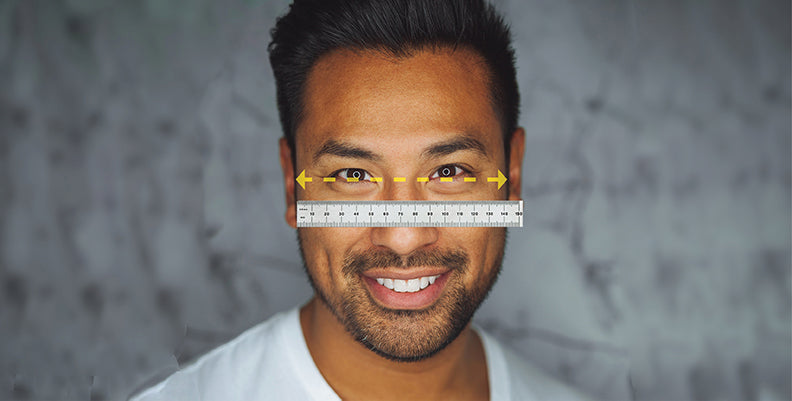
If you don't want to carry around a ruler while your shopping you can get an approximate value of the frame width with the dimensions from the manufacturer.
Just double the value of the Eye Size (one for each lens) and add the Bridge measurement and it should get you fairly close to the overall width of the frame.
2(Eye Size) + Bridge = approx. Frame Width
There’s one more thing to consider when it comes to finding the perfect fit and that’s the nose bridge orientation. Some people can have a low or a high nose bridge profile which can make selecting the right frames a little tricky.
Plastic/acetate frames without nose pads tend to sit low for people with a low nose bridge. Eyeglass frames that sit low tend to rest on the cheeks and every time you make a facial expression your eyeglasses will move as your cheeks raise up or down.
Eyeglass frames with nose pads are the best solution for this issue. Nose pads are made to be adjusted and you can secure a better fit by fine-tuning the nose pad position.
There are also frame manufacturers that make a low bridge frame with extended plastic nose rests to accommodate the low bridge. They are sometimes referred to as an “Asian-fit” frame.
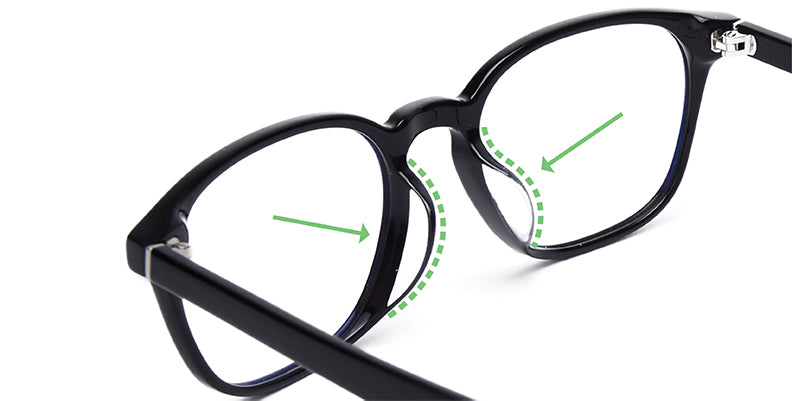
Prescription eyeglass frames with a low bridge or an Asian-fit have extended nose bridge rests to allow for a better fit around the nose keeping the frame in the correct position.
A high nose bridge can also cause fitting issues due to the eyeglasses sitting too high on your face. This happens because the nose bridge width is too narrow and does not sit flush around the nose bridge.
Eyeglass frames with nose pads can also alleviate this problem because they can be adjusted to the correct width. Eyeglass frames with a wider nose bridge width would be ideal for this situation. A keyhole bridge may also provide relief as they tend to be wider than the conventional bridge.
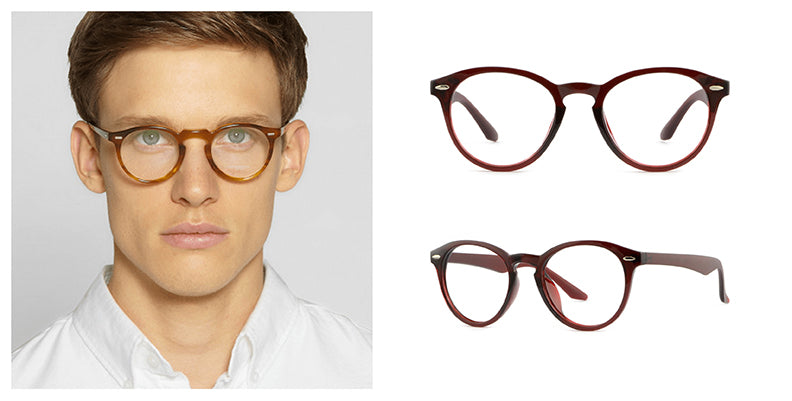
Luckily, there are frame manufacturers that make high bridge frames. Oakley has created a line of eyeglass frames with a modular nose bridge so you can select which ones fit you best.
Sunglasses should have a wider fit than prescription eyeglasses. Sunglasses are meant to protect your eyes from harmful UV rays emitted by the sun and provide comfort in seeing during extremely bright conditions.
The wider fit allows for greater coverage around your eye. This increases the surface area that’s covering the eye and also decreases any light going over or around the lenses. Wrap-around frames provide the best coverage because they match the contour of your face.
The final tip for finding eyeglasses with the perfect fit is to try them on. You may be thinking that this is what you’ve always done in the past and it didn’t prove to be successful. However, this time you’re equipped with a deeper understanding of how the frame sizing works.
Taking what you’ve learned about the eyeglass frame dimensions, you can go through a variety of frames and begin to identify sizes that are working. You can take note of the Eye Size, Bridge, and Temple Arm to see which combination works best with your face.
Just with this method alone, you can greatly reduce the amount of time and frustration you have with finding a pair of eyeglasses that fit perfectly.
Contact lenses are growing in popularity because, compared to glasses, they have a lot more maneuverability, they’re practically invisible and generally have a lower upfront cost. Just like all good things, there's a caveat to wearing contact lenses - they’re disposable. You choose between dailies, weeklies or monthlies from a variety of manufacturers but at some point, they go in the trash and you open a new pack.
Unless refractive surgery is an option for you, then there's no way around this vicious cycle. You have to shell out some cash to refill your contact lens supply so you can see clearly. Luckily, there are some “trade secrets” out there to alleviate the financial pressure of constantly replenishing your contact lenses. The following are tips and tricks you may not be aware of in getting those extra savings the next time you buy contact lenses.

If you have insurance coverage then consider yourself lucky. Insurance benefits always cushion the blow for medical expenses, especially on eyewear. The only problem is that most people don't fully understand their coverage.
Not all insurance benefits are the same and you may be unaware of certain features or copayments that apply with your coverage. You can’t expect your Eye Care Professional or optical retailer to know all of the details of your specific plan. There are too many benefits providers that offer a large variety of insurance products.
We highly recommend contacting your insurance provider and have a representative walk you through all of the key information about your specific plan. You will have a much better understanding of what is actually covered and any copayments where it applies. This can help you take advantage of all the features from your vision benefits and avoid any unexpected payments.
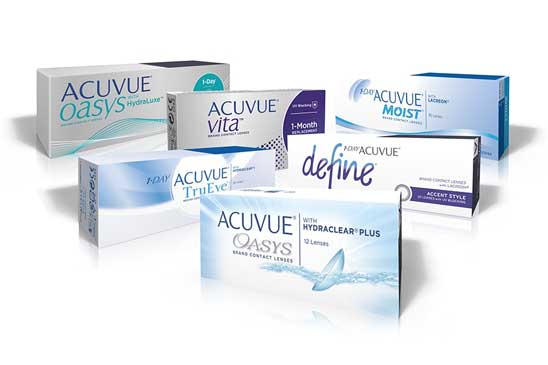
One of the easiest ways to save money on contact lenses is to buy larger quantities. Optical retailers will always offer price breaks for buying more. Typically they will structure it in terms of duration such as a 3 month, 6 month and yearly supply.
If your a daily or frequent user of contact lenses, your supply will run out and you’ll eventually need more. There's nothing worse than waking up in the morning only to realize you are fresh out of contact lenses when you need them most. Why not plan ahead and purchase in larger quantities. It will save you some cash and you won't have to think about it as much throughout the year.
You may not be aware of this, but you can actually request a trial pair to try the contact lenses you're interested in. Contact lens manufacturers always send optical retailers samples or trial pairs specifically for this reason. They want you to try the product in hopes that you will start wearing contact lenses or to switch to their brand of contact lens.
Not all contact lenses are the same. They can vary from material and design that may affect how comfortable they are or how well they will perform based on your specific needs. A trial pair will allow you to make an informed decision and know for sure the contact lens is suitable for your lifestyle.
Testing the contact lenses will reduce the risk of buying larger quantities to maximize your savings. You don't want to make that commitment on a year's supply if there's a chance you may not like them. With a trial pair, you know from your own experience that the product works and you will continue to use it in the future.
This may be the biggest takeaway from this article. Countless contact lens wearers are either unaware or don't take the time to take advantage of these mail-in rebates. Some of these rebates can save you up to $200 on your contact lens purchase.
There are a few things to note about the rebate program from the contact lens manufacturer. Typically, the mail-in rebates are limited to larger quantity orders, like a one year or a six-month supply. This generally may not be a bad thing because you receive double the savings on your purchase. You'll save more on larger quantity orders plus the mail-in rebate. There may also be restrictions on eligibility depending on where you buy the contact lenses (they usually exclude purchases made online or from big-box retailers like Costco.)
It's always best to ask your optical retailer if any mail-rebates apply or you can check online straight from the manufacturer. They will have the necessary forms and instructions to send your rebate. We recommended sending your rebate form right after you make your purchase. It will reduce the chance of you forgetting and it’ll be one less thing to do later on.
What you may not realize is that you can exchange the old prescription with the new one free of charge. As long as the boxes are unopened, unmarked and the contact lenses haven’t expired; you can go to your optical retailer and they will happily exchange the prescription for you.
Contact lenses vary in comfort, fit and performance. This is what makes the difference in price from each manufacturer and brand. While it may be best to have premium contact lenses for an optimal wearing experience, you can sacrifice some of these comforts to save a little bit of money.
Bear in mind getting a cheaper brand may not always be the best option for you. The drawbacks in comfort, fit and performance may prove to be too much of a compromise. Request a trial first and see if this alternative is worth the switch. What's the point in saving money on a product you don't enjoy? You’ll either hate wearing the contact lenses or you’ll end up going back to your previous brand.
Astigmatism is one of the common refractive errors associated with vision problems. Astigmatism is a focusing issue that causes blurriness in vision regardless of how far the object is.
Astigmatism occurs when the front of the eye is shaped more like a football instead of a round sphere. The irregular shape of the eye does not allow incoming light to be focused evenly on the retina. There are some areas of the eye that are steeper and some that are more spherical. The improper refraction of light causes blurriness and distortion (objects may appear stretched) at all distances.

Eyeglasses are the easiest and safest way to correct astigmatism. A comprehensive eye exam with an Eye Care Professional (Optometrist or Ophthalmologist) will identify the refractive error and prescribe corrective lenses needed to address the problem.
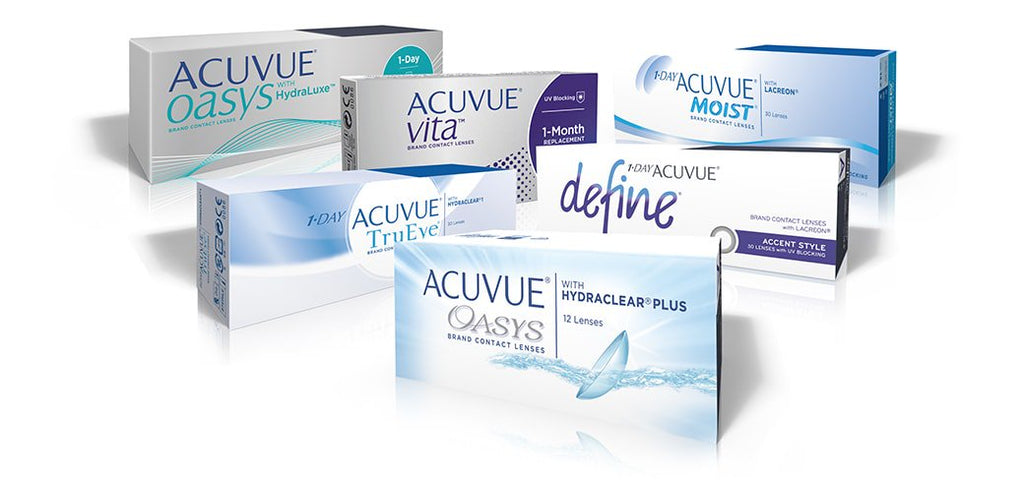
Contact lenses are a thin, plastic lens that rests directly on the eye to correct vision deficiencies. They have the added benefits of a wider field of view, moving freely without worrying about damaged glasses, and no obstructions to the face.
Contact lenses that correct astigmatism are called toric lenses. Depending on the severity of the astigmatism correction needed some patients may not be eligible for a contact lens correction.
Toric contact lenses or astigmatism contact lenses are typically more expensive than spherical contact lenses. Most people will opt-in for a spherical correction if the prescribed power for astigmatism is relatively low (based on the optometrists' referral).
Proper care and attention are required to ensure the safety of the eyes. They may not be the best option for everyone and there are certain restrictions that could prevent the use of contact lenses. It’s always best to consult with an Eye Care Professional to outline the best course of action.
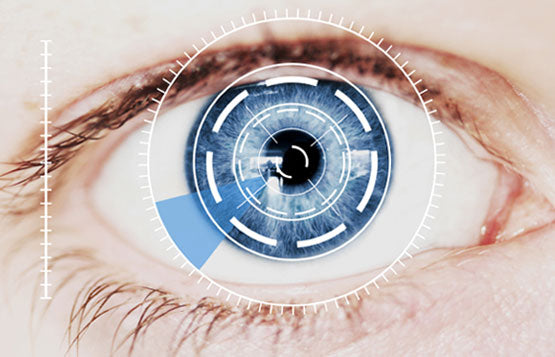
Nowadays refractive surgery is a safe and viable method to correct vision problems. Refractive surgeries are potentially a permanent solution to deficiencies in vision by reshaping the cornea.
In most cases, this will eliminate the need for eyeglasses or contact lenses. There are a variety of refractive surgeries available. Booking a consultation with an Eye Care Professional will outline the best option and the next steps to move forward.
If you have gotten an eye exam in the past, either from an optometrist or ophthalmologist, you’re usually given a piece of paper (at least the good ones) at the end of the exam. This paper contains a bunch of abbreviated terms and numbers that they call your eyeglass prescription.
For most people, you look at it and you have no clue where to begin.
You may have heard the terms nearsightedness, farsightedness, astigmatism, and progressives but have no way to determine how that relates to your prescription.
This article will provide a quick and easy guide for reading your eyeglass prescription. Hopefully, it will give you a better understanding of what’s going on between the lines.
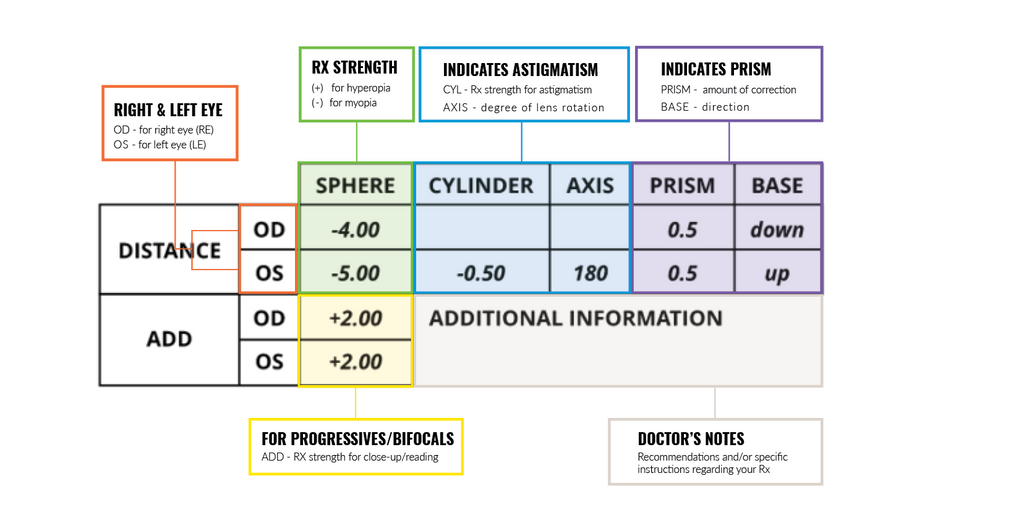
When you look at your prescription, you’re probably wondering where to start. Some people may not even bother and let their Eye Care Professional deal with it.
But clearly, if you’ve actively clicked this link then you’re a little bit curious or even adamant at finally being able to read your prescription (kudos to you).
Let's continue.
The first thing is to determine the Right and Left eye prescriptions. If you look on the left-hand side of the sheet, there are abbreviated terms. You will see O.D., O.S., and sometimes O.U.
These terms are indicators for the right and left eye:
O.D. = “oculus dexter” Latin for RIGHT eye
O.S. = “oculus sinister” Latin for LEFT eye
O.U. = “oculus uterque” Latin for BOTH eyes
Why not just label them left and right?
Similar to many terminologies in medicine, anatomy, and law, they are Latin based subjects that still use the original terms even to this day.
There are some optometry practices that have opted out of Latin based terminology and have made it simpler by using terms like RE for “right eye” and LE for “left eye”
Now that you can tell the difference between your left and right eye, you can now begin to figure out what the numbers depict in your prescription.
Sphere (SPH)
This portion will determine if you are nearsighted or farsighted. The numbers will be displayed as either "+" or "-". A "+" will indicate that you are farsighted and conversely, a "-" will indicate nearsightedness.
The number that follows the "+/-" symbol is the amount of lens power needed to correct your vision. The 0 acts as a baseline and indicates no spherical correction is needed. The farther the number deviates from 0 (either "+/-") the stronger the prescribed power. Lens powers are measured in diopters.
Cylinder (CYL)
This section of your eyeglass prescription will identify the astigmatism correction you may need. There will be cases where this portion will be left blank or will have the terms “Sph” (only spherical correction needed) or “DS” (diopter sphere). This just means that you have little or no astigmatism that needs correction.
Axis
The axis value works in conjunction with your cylinder power. The axis value ranges from 1-180 (measured in degrees) and signifies how much the lens should be rotated to correct blurriness caused by astigmatism.
Correcting vision problems associated with astigmatism requires a corresponding axis value. Without the axis value, the lens power will not be in the correct position.
Rotating the lens 90 degrees away from the axis value will give you the total power of the lens. You can then identify the cylinder power by subtracting the sphere power to the total power of the lens.
Cylinder Power = Total Power - Sphere Power
For the average person, you will rarely have the opportunity to measure your lens power with a lensometer.
I mean why would you?
It’s more for the purpose of awareness with your prescription. If you see that there is a value placed in the cylinder but none in the axis (and vice versa) then there must be an error somewhere in the way the prescription is written.
ADD/Addition
Presbyopia patients require both distance and reading corrections. The ADD or Addition is the prescribed magnifying power for the lower portion of a multifocal lens. The value is always a "+" power and is implied even when there is no "+". The ADD power will always match for both eyes.
Nowadays most people will opt-in for a pair of progressive lenses also known as "no-line bifocals". Progressive lenses are versatile because they have 3 distance zones (distance, intermediate, and reading); perfect for day-to-day activities. They are also popular because they have better aesthetics with no hard lines visible on the lens.
Other multifocal lens designs:
Prism
This section will usually be left blank or omitted for most people. Only a small percentage of prescribed vision correction will include prism.
It represents the prismatic power needed to correct eye alignment issues. It’s measured in prism diopters and may appear as “p.d” or a superscript triangle followed by a numerical value.
While sphere and cylinder are measured in increments of 0.25D; prism is listed in increments of 0.5D. Prism values are followed by a direction that indicates where the lens should be placed for optimal correction.
Prism directions are abbreviated and are listed as follows:
BU = Base Up
BD = Base Down
BI = Base In (towards the nose)
BO = Base Out (towards the ear)
There is a distinction between a contact lens prescription and an eyeglass prescription. A common misconception is to assume that they are interchangeable. You cannot purchase contact lenses with your eyeglass prescription.
The distance of the corrective lens relative to the position of the eye is important
The distance between your eye and the corrective lens, whether it's a contact lens or eyeglass lens, makes a big difference in refractive power. Contact lenses rest directly on your eye while your eyeglass lenses are typically 12mm from your eye.
Contact lenses will also have unique information such as the base curve and diameter of the lens. During a contact lens exam, your eye doctor will take measurements of your eye to ensure that the lens fits on your eye comfortably.
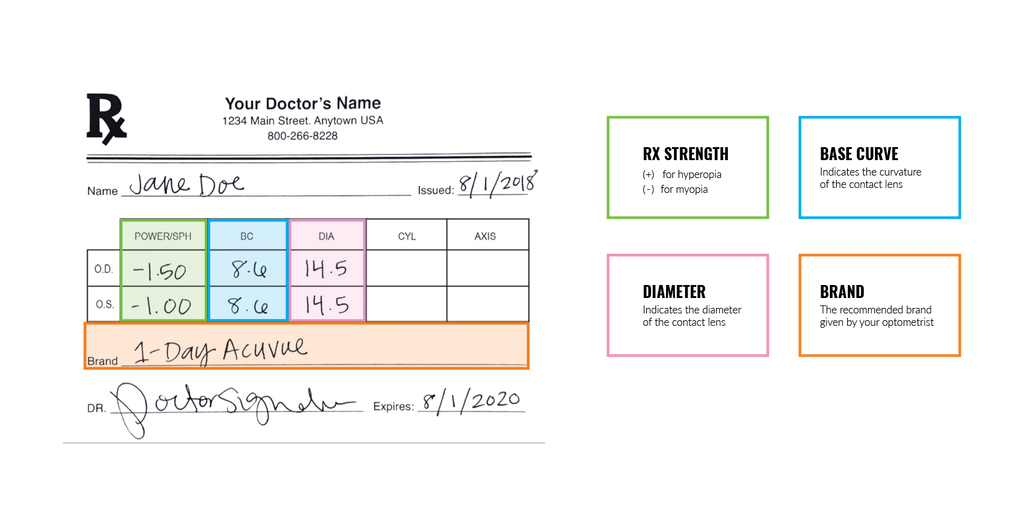
Your eye doctor will usually include recommendations for your lenses included in your eyeglass prescription. These can be specific lens brands, material, design, and treatments.
For the most part, unless otherwise stated by your doctor, they are suggestions on products that will give you the most comfort when wearing your glasses.
You may choose to opt-out of these suggestions due to economical restrictions or personal preference. Always consult with your eye doctor first before making these decisions.
Your eyeglass prescription is yours to keep after a comprehensive eye exam. The Optometry Practice is required by law to provide you with a copy of your prescription after the eye exam.
Your eye doctor should give you a copy of your prescription regardless of whether you have asked for it or not.
You are not obligated to purchase prescription eyewear directly from your eye doctor and they do not have a right to charge you for the release of your prescription.
This gives you the freedom to choose the optical retailer you would like to buy your glasses from.
Getting a better understanding of your eyeglass prescription will help you in making an informed decision about your corrective eyewear. It can also make the process of getting glasses a lot smoother and more enjoyable. (Because we all love shopping for glasses!)
It will save you a lot of time and potential frustration by being aware of key elements to consider when shopping for ophthalmic frames and prescription lenses. You will also be able to identify potential errors in the prescription which happens from time to time. (We’re all human)
It’s always best to open the conversation with your eye doctor, optician, and optical retailer to ensure you are getting the best vision correction for your specific needs. They will be more than happy to help and with a deeper knowledge of your prescription you can engage in a better dialogue.
Presbyopia is a common refractive error that occurs later in life as the eyes age. Near vision is affected and makes it difficult to focus on objects up close.
Presbyopia occurs as part of the natural process of ageing. The natural lens of the eye hardens over time and restricts the eye from focusing light directly on the retina. The effects of ageing also compromise the muscle fibres around the eye adding to difficulties in focusing.
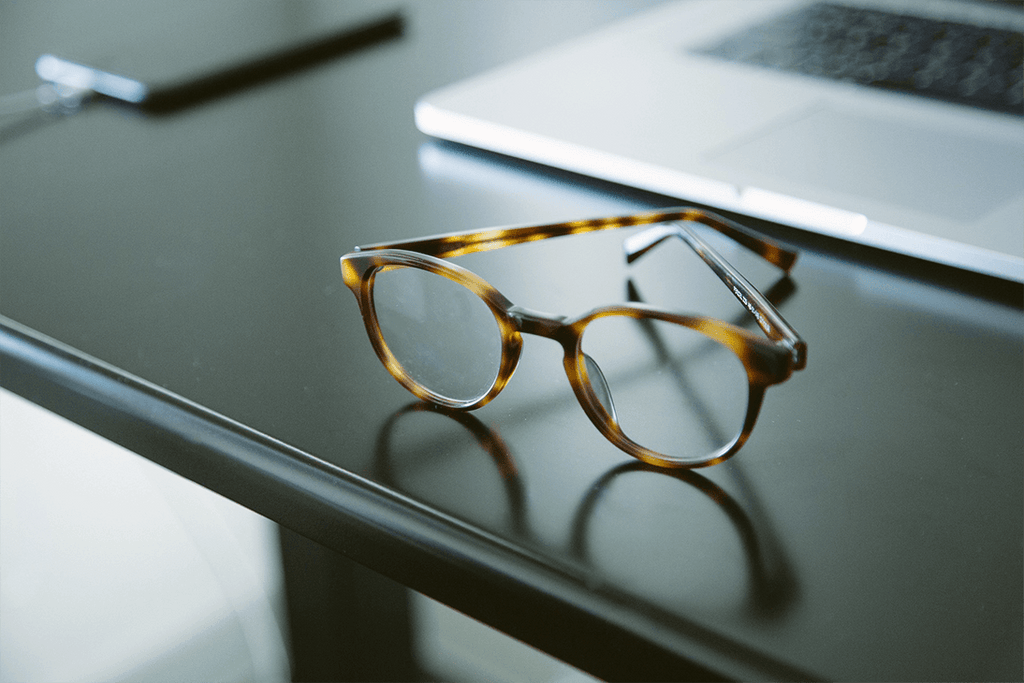
Eyeglasses are the easiest and safest way to correct presbyopia. A comprehensive eye exam with an Eye Care Professional (Optometrist or Ophthalmologist) will identify the refractive error and prescribe corrective lenses needed to address the problem.
Typically, presbyopia patients will require either a multifocal lens or reading glasses. Multifocal lenses are available in multiple lens designs like a bifocal or a progressive lens. Reading glasses can be purchased over the counter or made custom by an optical retailer depending on the lens correction needed.

Contact lenses are a thin, plastic lens that rests directly on the eye to correct vision deficiencies. They have the added benefits of a wider field of view, moving freely without worrying about damaged glasses, and no obstructions to the face.
Proper care and attention are required to ensure the safety of the eyes. They may not be the best option for everyone and there are certain restrictions that could prevent the use of contact lenses. It’s always best to consult with an Eye Care Professional to outline the best course of action.
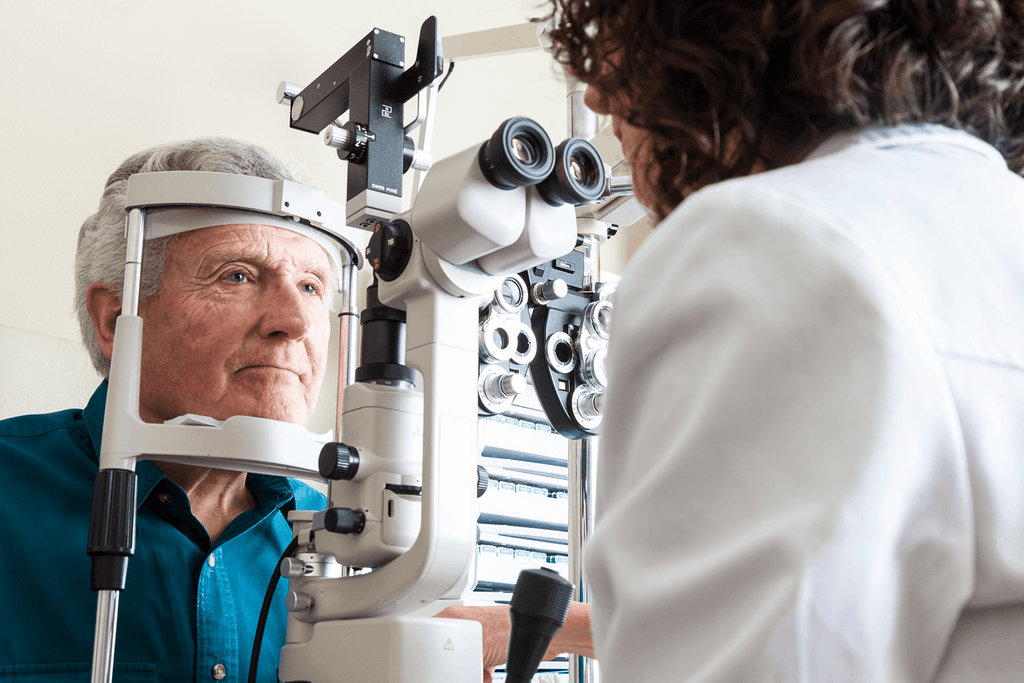
Nowadays refractive surgery is a safe and viable method to correct vision problems. Refractive surgeries are potentially a permanent solution to deficiencies in vision by reshaping the cornea.
In most cases, this will eliminate the need for eyeglasses or contact lenses. There are a variety of refractive surgeries available. Booking a consultation with an Eye Care Professional will outline the best option and the next steps to move forward.
Hyperopia, often referred to as farsightedness, is one of the common refractive errors associated with vision problems. It’s the inability to see objects up close but objects at a distance are clear (hence the name - farsighted).
This type of refractive error may go unnoticed as a child but symptoms start to appear as they get older. People may also experience hyperopia differently. In severe cases, vision might be blurry at all distances.
Hyperopia is the result of improper focusing caused by an irregularly shaped eyeball. It happens when the eyeball is too short and the light entering the eye is focused behind the retina. Blurriness in your vision is caused by the light focusing behind the retina instead of directly on top. Hyperopia can also be caused by an abnormally shaped cornea and/or lens.

Eyeglasses are the easiest and safest way to correct farsightedness. A comprehensive eye exam with an Eye Care Professional (Optometrist or Ophthalmologist) will identify the refractive error and prescribe the corrective lenses needed to address the problem.

Contact lenses are a thin, plastic lens that rests directly on the eye to correct vision deficiencies. They have the added benefits of a wider field of view, moving freely without worrying about damaged glasses, and no obstructions to the face.
Proper care and attention are required to ensure the safety of the eyes. They may not be the best option for everyone and there are certain restrictions that could prevent the use of contact lenses. It’s always best to consult with an Eye Care Professional to outline the best course of action.

Nowadays refractive surgery is a safe and viable method to correct vision problems. Refractive surgeries are potentially a permanent solution to deficiencies in vision by reshaping the cornea.
In most cases, this will eliminate the need for eyeglasses or contact lenses. There are a variety of refractive surgeries available. Booking a consultation with an Eye Care Professional will outline the best option and the next steps to move forward.
Myopia, often referred to as nearsightedness, is one of the common refractive errors associated with vision problems. It’s the inability to see objects at a distance but objects up close are clear (hence the name - nearsighted).
Myopia is the result of improper focusing caused by an irregularly shaped eyeball. It happens when the eyeball is too long and the light entering the eye is not focused directly on the retina. Blurriness in your vision is caused by the light focusing before it reaches the retina. Myopia can also be caused by an abnormally shaped cornea and/or lens.

Eyeglasses are the easiest and safest way to correct nearsightedness. A comprehensive eye exam with an Eye Care Professional (Optometrist or Ophthalmologist) will identify the refractive error and prescribe the corrective lenses needed to address the problem.
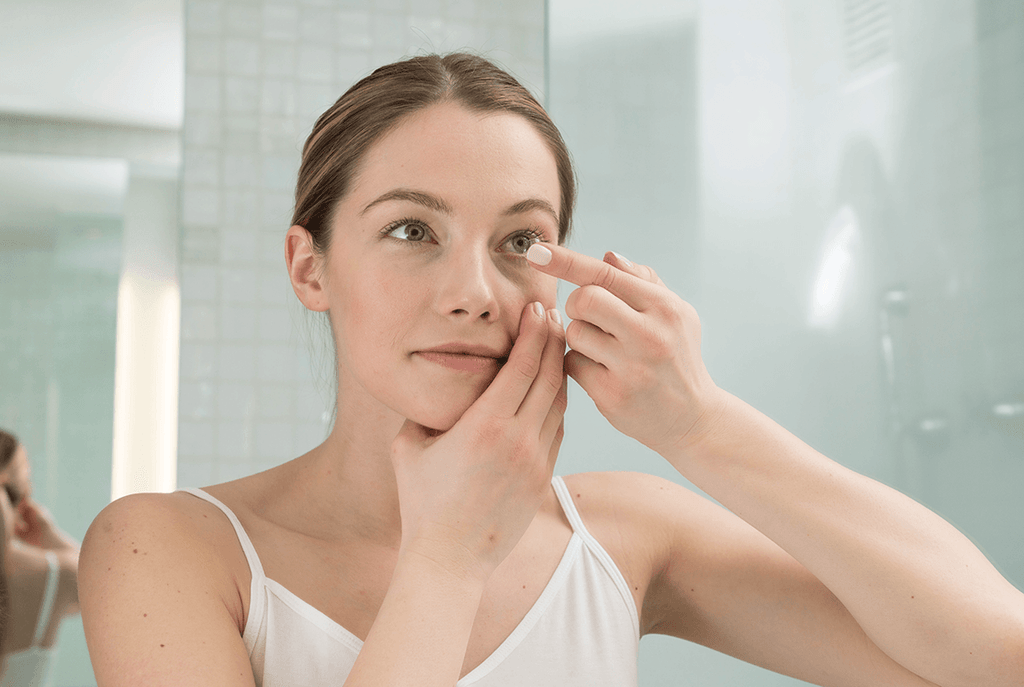
Contact lenses are a thin, plastic lens that rests directly on the eye to correct vision deficiencies. They have the added benefits of a wider field of view, moving freely without worrying about damaged glasses, and no obstructions to the face.
Proper care and attention are required to ensure the safety of the eyes. They may not be the best option for everyone and there are certain restrictions that could prevent the use of contact lenses. It’s always best to consult with an Eye Care Professional to outline the best course of action.

Nowadays refractive surgery is a safe and viable method to correct vision problems. Refractive surgeries are potentially a permanent solution to deficiencies in vision by reshaping the cornea.
In most cases, this will eliminate the need for eyeglasses or contact lenses. There are a variety of refractive surgeries available. Booking a consultation with an Eye Care Professional will outline the best option and the next steps to move forward.
Changes in your vision happen all the time. There are instances where the changes can pass and are treated simply with a little bit of rest. If you’ve ever stayed up late and felt your eyes having trouble focusing you can attest to this momentary poor vision.
Lack of sleep, stress or eye strain caused by visual fatigue (picture long days on a computer) can temporarily affect how well you’re seeing. This makes it difficult to determine if your vision problems are a case of tired eyes or if it may be time to book an appointment with your Eye Care Professional.
Luckily, there are some early warning signs to look out for that could be directly related to changes in vision. Although the sudden loss of vision is possible, the changes are usually gradual and you may not even notice right away.
If you’re constantly experiencing any of these symptoms, it may be a good indicator that it’s time to contact your Eye Care Professional. They can give you greater insight into the health of your eyes and may recommend an adjustment in your prescription.

Right off the bat, if you experience unexpected blurriness in vision when you’re already wearing glasses - there’s a good chance your vision has changed. Your glasses are designed to correct deficiencies in seeing clearly and if they’re not working you may need to adjust the prescribed power on the lens.
Booking a comprehensive eye exam is strongly recommended when symptoms of blurred vision occur, especially when you're wearing glasses. A comprehensive eye exam will not only help you in getting the appropriate lens correction but it may identify any underlying eye health issues at the earliest stage.
Squinting is a natural way of improving focus and clarity in your vision. You may not realize how often you’re actually squinting, mostly because it happens automatically as you need more clarity.
However, excessive squinting can be an indicator that your vision has changed. If you find yourself squinting every time you’re trying to read a road sign, use a computer/laptop or reading a book then a change in your eyeglass prescription may be necessary.
Excessive squinting means you’re constantly putting unwanted strain on your eyes. This eyestrain will worsen over time and could cause clarity in your vision to decline. It could lead to a stronger prescription to correct your vision in the future.

Eye strain or the feeling of your eyes hurting (or tired eyes) can be attributed to multiple factors. These factors include the amount of sleep you get, how much computer work you're doing, or even seasonal allergies. However, in cases where eyestrain is persistent; it could signal a change in corrective eyewear. Either with a new prescription or a different type of prescription lens altogether.
If you feel your eyes are hurting or tired when you have glasses on but then subsides when you take your glasses off, consult with an Eye Care Professional as soon as possible. This is a clear indicator you need an adjustment in your prescribed power.

Many people may not experience noticeable changes in their vision but they will report an increase in headaches. Headaches are usually one of the first signs of an update in your eyeglass prescription.
People who are nearsighted (myopia) tend to experience headaches at the front of the head or right above the brow line. Meanwhile, those who are farsighted (hyperopia) will get headaches when reading or looking at things up close for extended periods.

People may have a “clear” vision in the daytime but begin to face challenges as it gets darker in the evening. This is due to the fact that there is more available light during the day. Your pupils are smaller and provide a greater depth of field in the daytime.
At night, however, your pupils begin to dilate to take in more light. This makes blurriness caused by vision deficiencies (hyperopia, myopia, astigmatism, and presbyopia) become more apparent.
Although experiencing one or more of these symptoms may not always translate into a problem in your vision, It’s always recommended to schedule regular eye exams. Your optometrist or ophthalmologist can monitor the health of your eyes. They will determine if your current prescription still works as well as screen diseases or eye conditions.
Contact lenses are convenient and relatively safe. However, special care and attention are needed to ensure that your eyes are safe from hazards or infection. Here are 5 simple steps to properly take care of your contact lenses.
Contact lenses have become so common that some people opt out of wearing glasses and wear contact lenses as an alternative.
Contacts give you the freedom from worrying about glasses staying on your face and they remove the distraction that glasses can have on your facial features.
Although wearing contact lenses are convenient and relatively safe, special care and attention are needed to ensure that your eyes are safe from potential hazards or infection.
Cleaning your contact lenses and the best practices for putting them on are fairly straightforward. However, it can be easy to miss a step or forget the importance of proper hygiene.
Unfortunately, cutting corners when it comes to your contact lens routine can lead to irritating eye infections or the risk of damaging your eyes. All of which may prevent you from wearing contact lenses for an extended period.
Let's take a look at How To Clean Your Contact Lenses in 5 Simple Steps (Infographic)


Millions of Canadians leave extended health benefits unclaimed. We all know (or at least we should) that these health benefits expire and renew in a given period.
Whether you’re getting health benefits through work or a personal insurance plan, you’re paying for your coverage regardless if you make a claim or not.
As we all know, they don’t reimburse you for these unclaimed benefits so these are essentially hundreds of dollars wasted never to be seen again.
The best way to maximize your insurance benefits is to know exactly what they cover and their limitations. This article will go over the basics of understanding your policy and some tips and tricks of potentially getting a little bit more out of your vision plan.
First thing is to contact your vision care provider and ask what you’re covered for and the parameters for your coverage. Information like copays, allowance, lens enhancements and the total amount covered are important to know so you’re aware of any limitations to your plan.
Not all vision care plans are similar and can have varying rates or features. For the most part, they will cover an eye exam and a pair of glasses (frames and lenses). Rates of coverage can vary from plan to plan. Below are key points to consider to get the most out of your insurance plan.
A fixed amount that you pay regardless of what the optical retailer charges you.
The vision care for your insurance plan will pay a percentage of your glasses up to a specified amount.
For example, your plan could cover 80% up to $250.00 of your eyeglasses. This means your vision care plan will pay for 80% of the cost of your glasses up to a maximum of $250. You will be responsible for the difference in coverage either 20% of the cost or anything over $250.
Example 1: Plan covers 80% up to $250.00 and the total cost of the glasses is less than or equal to the $250 threshold
|
Cost For Glasses |
Allowance (80%) |
You Pay (20%) |
|
$250 |
$200 |
$50 |
The vision plan will only cover 80% of the $250 since it is less than the maximum coverage alotted
Example 2: Plan covers 80% up to $250.00 and the total cost of the glasses is greater than the $250 threshold
|
Cost For Glasses |
Allowance (max) |
You Pay (balance) |
|
$350 |
$250 |
$100 |
The vision plan will use the maximum coverage alloted for $250 since the cost is above the maximum coverage threshold
lens upgrades like photochromic/transition lenses, high index lenses, anti-glare coating, etc. are considered electives and may not be covered by your plan or have a separate allowance.
Contact lens exams and contact lenses are also classified as electives. Coverage rates may change or for some plans, they may not even be covered at all.
It’s also a good thing to know when the renewal dates are for your vision coverage. Insurance claims are based on the date of service regardless of when you receive your eyewear or if there have been any changes to your prescription.
This means that if your coverage renews every two years (like most plans), and you purchase glasses with your coverage on December 31, 2019; you won’t be able to submit a claim until December 31, 2021.
Most plans will cover prescription sunglasses, but only some will allow you to claim non-prescription sunglasses. This may come in handy if you don’t need glasses or your existing pair does not need to be replaced.
Your plan can also have a separate Health Spending Account (HSA) or Flex Spending Account for coverage on a broad range of medical products and that could include non-prescription sunglasses.
Insurance providers can have partnerships or agreements with specific optical retailers and optometry practices. These preferred retailers, or in-network providers, can have special promotions or discounts exclusive to people under your benefits plan.
Find out if there are any in-network providers and simply ask the retailer what the terms of the discounts are. They can assist you with all of the details associated with preferred rates and promotions. This can help you be aware of added discounts for your eyewear and get the most out of your vision care benefit plan.
Typically these discounts and promotions are constant. They will be available to you regardless if you’re making a claim or not. This may be useful for making eyewear purchases before your coverage has renewed.
There are a number of insurance plans that include a Health Spending Account (HSA) or Flex Spending Account (FSA) along with vision care benefits. These accounts can be used for any products or services outlined by the Health Spending Account.
It’s good to be aware of what is eligible to claim under these accounts as they can be quite comprehensive. Some will allow you to bill for gym memberships or even sporting goods.
Most importantly you can use these accounts to cover your eyewear expenses. If you’re under an allowance based program you can bill the difference that you paid for complete coverage on your purchase.
Some plans may even let you claim non-prescription sunglasses under the HSA. These accounts expire and will renew after a given period. This means you can potentially take advantage of any remaining balance of your HSA to purchase a pair of non-prescription sunglasses or another pair of prescription eyewear.
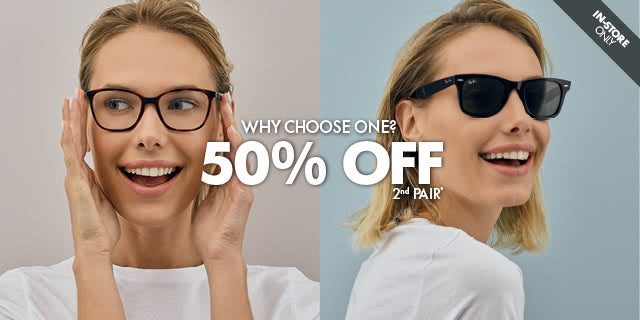
[Source: https://www.opsm.com.au/special-offers/50-percent-off-second-pair]
Optical retailers often have discounts for purchasing a second pair of glasses. If you wear glasses on a daily basis this could be a good time to purchase a set of prescription sunglasses or a second pair of eyeglasses.
Typically optical retailers will offer at least 20% off on the second pair you purchase. Careful planning can make purchasing two pairs of glasses quite affordable. It could also maximize the number of glasses you can get depending on your insurance coverage.
You may be wondering why you would go through the hassle of using all of your benefits if it’s not needed. This rationale could be considered as ‘only using what you need’ but simply put you’ve already paid for these benefits.
Get the most out of your insurance benefits and actually use them. Book your annual eye exam and get a new pair of glasses when your coverage renews. Routine eye exams are a great way to monitor the health of your eyes, and a new pair of glasses can be an excellent fashion accessory.
A comparative analysis of the differences between Standard and Computer Progressive Lenses.

An infographic that helps you understand Blue UV Light: What it is, where it comes from, and how it affects your eye health.
